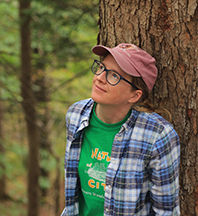Week of August 27, 2023 – September 2, 2023
by Anna Stunkel, Environmental Educator
Late August is a special time of year in which goldenrods and some other aster flowers are just beginning to bloom. As this happens, a bustling community of insect pollinators awakens, marking the gradual transition from summer to fall. When walking around in meadows of goldenrod and other late summer wildflowers, I often find myself pausing to look very closely at the blossoms for insects. Some of these bugs are very tiny, while others have showy and colorful patterns.
Just the other day, I came across a huge variety of pollinators along the Backyard Wildlife Trail and in the new property field. Native wildflowers that have been planted in this large field are abuzz with life. On a single brief walk, I came across several species of native bees, wasps, beetles, and flies. Many Goldenrod Soldier Beetles were crawling around on the blossoms in particular. These are beneficial pollinators, and their larvae feed on pests such as aphids. I also marveled at the bright cadmium orange and black coloration of a Swift Feather-legged Fly. Hence the name, this fly has feather-like structures on its legs, and it’s a pollinator as well.
You may think of the Honeybee as the quintessential pollinator, but next time you go for a stroll in an open meadow, see how many other bees, wasps, beetles, and flies you can discover hanging around on flowers. Honeybees were introduced from Europe, but we also have a plethora of native bees in this area. New York state is home to over 400 species of bees!
As all of these pollinators are busy finding nectar and pollen, there are also predators lying in wait. During my recent walk, I noticed the first Ambush Bug that I’ve spotted this season. These sneaky bugs sit in wait for pollinators to land on flowers, and then grab their prey using mantis-like front legs. To find Ambush Bugs, you must look very closely at flower blossoms considering their diminutive size and amazing camouflage. Goldenrod is a favorite perch for this species.
A wildflower meadow may be an expansive place, but individual flowers can reveal many small worlds interacting together.


